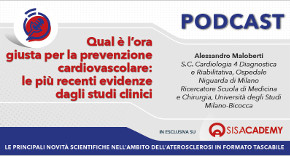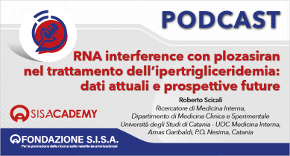 Rivista in lingua italiana
Rivista in lingua italiana
riservata ai Soci SISA
Ultimo numero:
Anno 16 • N.1/2025
Abstract
Isolated low levels of high-density lipoprotein cholesterol are associated with an increased risk of coronary heart disease: an individual participant data meta-analysis of 23 studies in the Asia-Pacific region
Huxley RR, Barzi F, Lam TH, Czernichow S, Fang X, Welborn T, Shaw J, Ueshima H, Zimmet P, Jee SH, Patel JV, Caterson I, Perkovic V, Woodward M.
Circulation 2011;124:2056-64
BACKGROUND: Previous studies have suggested that there is a novel dyslipidemic profile consisting of isolated low high-density lipoprotein cholesterol (HDL-C) level that is associated with increased risk of coronary heart disease, and that this trait may be especially prevalent in Asian populations.
METHODS AND RESULTS: Individual participant data from 220 060 participants (87% Asian) in 37 studies from the Asia-Pacific region were included. Low HDL-C (HDL <1.03 mmol/L in men and <1.30 mmol/L in women) was seen among 33.1% (95% confidence interval [CI], 32.9-33.3) of Asians versus 27.0% (95% CI, 26.5-27.5) of non-Asians (P<0.001). The prevalence of low HDL-C in the absence of other lipid abnormalities (isolated low HDL-C) was higher in Asians compared with non-Asians: 22.4% (95% CI, 22.2-22.5) versus 14.5% (95% CI, 14.1-14.9), respectively (P<0.001). During 6.8 years of follow-up, there were 574 coronary heart disease and 739 stroke events. There was an inverse relationship between low HDL-C with coronary heart disease in all individuals (hazard ratio, 1.57; 95% CI, 1.31-1.87). In Asians, isolated low levels of HDL-C were as strongly associated with coronary heart disease risk as low levels of HDL-C combined with other lipid abnormalities (hazard ratio, 1.67 [95% CI, 1.27-2.19] versus 1.63 [95% CI, 1.24-2.15], respectively). There was no association between low HDL-C and stroke risk in this population (hazard ratio, 0.95 [95% CI, 0.78 to 1.17] with nonisolated low HDL-C and 0.81 [95% CI, 0.67-1.00] with isolated low HDL-C).
CONCLUSION: Isolated low HDL-C is a novel lipid phenotype that appears to be more prevalent among Asian populations, in whom it is associated with increased coronary risk. Further investigation into this type of dyslipidemia is warranted.

Area Soci
Eventi
39° Congresso Nazionale
 39° Congresso Nazionale
39° Congresso NazionaleRoma, 23-25 novembre 2025
Save the date




 Spring Meeting Gruppi Giovani SID, SIGG, SIIA, SIMI, SIPREC, SISA
Spring Meeting Gruppi Giovani SID, SIGG, SIIA, SIMI, SIPREC, SISARimini, 6-8 aprile 2025
[continua a leggere]
 SISA LIPID ACADEMY - Corso avanzato di lipidologia clinica
SISA LIPID ACADEMY - Corso avanzato di lipidologia clinicaModena, 4-5 Luglio 2024
[continua a leggere]Giornale Italiano Arteriosclerosi
HoFH today
 Rivista Italiana della
Rivista Italiana della
Ipercolesterolemia
Familiare Omozigote
Anno 6 • N.1/2024
Rivista NMCD
Diateca
[continua a leggere]
[continua a leggere]
Newsletter
il vostro indirizzo di posta elettronica
Progetto LIPIGEN

Nuovo sito dedicato al Progetto LIPIGEN
Progetto LIPIGEN - Vecchio portale
E' necessario essere loggati come utente
Lipigen per poter accedere alla pagina
PROject Statin Intolerance SISA
PROSISA – PROject Statin Intolerance SISA
E' necessario essere loggati come utente
PROSISA per poter accedere alla pagina
GILA - Lipoprotein Aferesi
Gruppo Interdisciplinare Lipoprotein Aferesi
(Accesso Gruppo GILA-Lipoprotein Aferesi)
E' necessario essere loggati come utente del Gruppo GILA per poter accedere
Gruppo Interdisciplinare Lipoprotein Aferesi
(Documentazione ad accesso libero)
Pagina informativa per medici e pazienti










